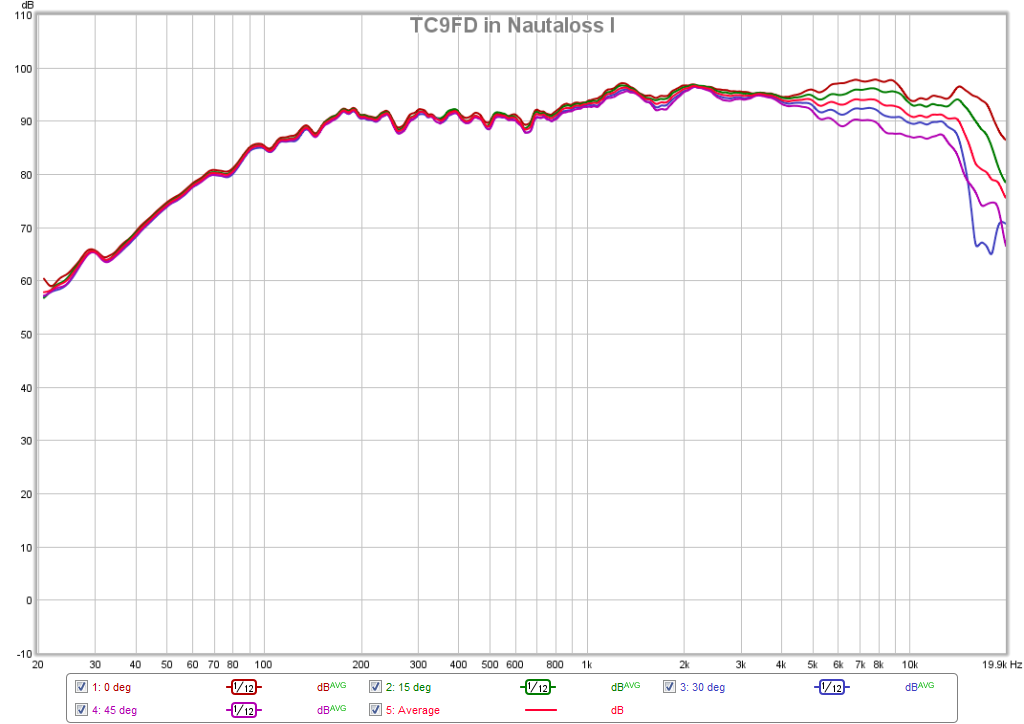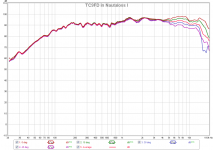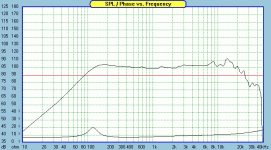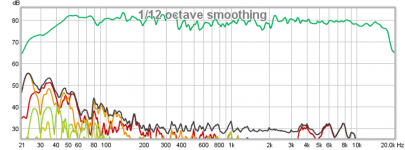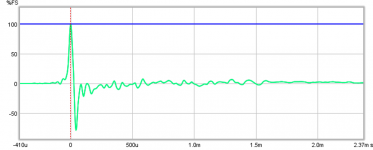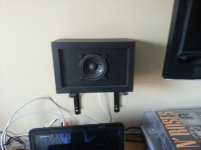Of course. That's one way of presenting data. MA state they do not use software smoothing; they evidently use a wide dynamic range as an alternative. Similar effect, just as adjusting the horizontal axis can have an apparent visual effect also with the same actual data. They are a manufacturer. It is not in their interest to present data in the worst possible light. But the scales are there in black and white for people to read, so by definition, it cannot be called a lie, misleading or any similar term. If people don't read it, they are not best placed to moan about it after the event.
Can we please all be reasonable for a moment, since this is all getting very silly. I for one have got a vile headache anyway thanks to the dreaded lurgy, and the manner of the thread in general at present is not likely to get anybody anywhere productive. So.
-Markus, nobody doubts you don't like the drivers. Fair enough. They can't be all things to all people.
-Nobody is doubting your measures either. They are clearly solid, and concur with the published plots, as has been noted by several people here, rather well once the dramatically different scale you have used is accounted for.
-No 4in wideband drive unit has wonderful off-axis response once you get past about 30 degrees. That's just the physics at work. As several have already stated. If you know better, then you would be well advised to get the funding together & build it. You will make lots of money.
-Out to 90 degrees off axis, placing the mic. on the same plane as the driver itself, is, TBH, completely unrealistic expectations. Not many tweeters do all that well so far off, and a 4in widebander = zero chance to the best of my knowledge. Sorry, but that is the truth as far as I am aware.
Can we please all be reasonable for a moment, since this is all getting very silly. I for one have got a vile headache anyway thanks to the dreaded lurgy, and the manner of the thread in general at present is not likely to get anybody anywhere productive. So.
-Markus, nobody doubts you don't like the drivers. Fair enough. They can't be all things to all people.
-Nobody is doubting your measures either. They are clearly solid, and concur with the published plots, as has been noted by several people here, rather well once the dramatically different scale you have used is accounted for.
-No 4in wideband drive unit has wonderful off-axis response once you get past about 30 degrees. That's just the physics at work. As several have already stated. If you know better, then you would be well advised to get the funding together & build it. You will make lots of money.
-Out to 90 degrees off axis, placing the mic. on the same plane as the driver itself, is, TBH, completely unrealistic expectations. Not many tweeters do all that well so far off, and a 4in widebander = zero chance to the best of my knowledge. Sorry, but that is the truth as far as I am aware.
Last edited:
The Alpair (and other Jordan derived drivers) are to the best of my knowledge and apparently to the rest of the forums, the state of the art with regards to your criteria.
Stop being the drunk who is looking for his keys under the lamppost or the treasurehunters who just redouble their effords and dig deeper when they don't find anything.
Change your point of view and old stuff you thought you knew will look new.
Stop being the drunk who is looking for his keys under the lamppost or the treasurehunters who just redouble their effords and dig deeper when they don't find anything.
Change your point of view and old stuff you thought you knew will look new.
Yes. The dispersion of a 3-4 inch cone driver is determined by physics, not wishful thinking. A 3 inch will have wider dispersion to a higher frequency than a 4 inch (at the price of less low end) . . . apart from that the dispersion is predictable without even looking at the graphs. What's not so predictable is how effectively any of the various dispersion-broadening "solutions" (phase plug, whizzer cone, "button" tweeter, progressive decoupling) will widen dispersion above that, or how they will "sound" in use. Experience tells me that charts and graphs won't answer that question . . . that what "looks good" may not sound good, and what sounds good may look . . . um . . . less than exemplary.What? By looking at this...
At some point you simply have to listen . . .
I've never heard the little Vifa displayed in xrk's most recent post - but it "looks" benign enough - note that if I'm not mistaken, the scaling isn't the same as the several others posted for the 7.3. Failing to correct for scaling differences or measurement conditions when comparing graphs can be in itself very misleading - whether that's to be judged as intentionally nefarious or simply incidental is up to the reader, I guess .
dizzy yet from all those laps around the carousel? - the golden ring you seek is imaginary, methinks
dizzy yet from all those laps around the carousel? - the golden ring you seek is imaginary, methinks
The Vifa shown by xrk is widely enjoyed by many. It does look better than the 7.3 on paper and I will not dismiss its performance, as I have not heard it. Listening again to the 7.3 last night, i am still impressed by its ability to go low and how wonderfully it images. That being said, I have come from listening to multiways and now find the top end a little harsh in comparison to some good dome tweeters. That being said, mine are not eNabled and i have not applied any smoothing at all. IN measuring mine last night, I found a very similar response to you Markus and based on what I hear and my general thoughts, I will be adding the TL Labs tweeter up top to see how they perform together. I would try the Vifa,but i am trying to get more efficient, not less.
This doesn't look bad
Faital Pro 3FE20 3" Speakers - Faital Pro 3FE20 mid-high speaker has a wide frequency range from 100Hz to 20kHz and has a lightweight neodymium magnet - Faital Pro 3FE20 40 watt 3" has an efficiency of 91dB SPL for all high quality mid-high applicati
Or this one
Faital Pro 4FE32 4" Speakers - Faital Pro 4FE32 mid-high speaker has a wide frequency range from 90Hz to 20kHz and has a lightweight neodymium magnet - Faital Pro 4FE32 60 watt 3" has an efficiency of 91dB SPL for all high quality mid-high applicatio
This doesn't look bad
Faital Pro 3FE20 3" Speakers - Faital Pro 3FE20 mid-high speaker has a wide frequency range from 100Hz to 20kHz and has a lightweight neodymium magnet - Faital Pro 3FE20 40 watt 3" has an efficiency of 91dB SPL for all high quality mid-high applicati
Or this one
Faital Pro 4FE32 4" Speakers - Faital Pro 4FE32 mid-high speaker has a wide frequency range from 90Hz to 20kHz and has a lightweight neodymium magnet - Faital Pro 4FE32 60 watt 3" has an efficiency of 91dB SPL for all high quality mid-high applicatio
I've never heard the little Vifa displayed in xrk's most recent post - but it "looks" benign enough - note that if I'm not mistaken, the scaling isn't the same as the several others posted for the 7.3. Failing to correct for scaling differences or measurement conditions when comparing graphs can be in itself very misleading - whether that's to be judged as intentionally nefarious or simply incidental is up to the reader, I guess .
dizzy yet from all those laps around the carousel? - the golden ring you seek is imaginary, methinks
I actually chose the same scale that MA uses: -10dB to +110dB in 10dB major increments. My absolute SPL is higher because I did not set volume to be exactly 2.83V and my distance was not 1m. Just showing angular dependence.
If you have not heard one, give it try. At $12 ea you can't go wrong.
I'm not a measurement guy, so don't be too surprised by the question - any chance that measures taken at different signal drive levels would not be exactly comparable - angular dependance notwithstanding? And could that be particularly germane with wide band drivers such as the Alpairs that as Scott and Mark would likely state whose function in the upper registers is specifically designed with controlled decoupling / micro-resonance behaviour. I've lived with A7s for several years now, and as much as I love them, wouldn't want to listen at a distance of 10ft at the sustained average levels seen in some of the graphs (i.e. mid to upper 90s or more) At those SPLs multiways with horn loaded compression drivers might be a more logical solution. or not
Then there's the question of all the conditions, size of baffle, mic calibration, etc. If it's not been addressed in this thread, assuming that all the conditions of measurements are identical among the various testers could lead to dissimilar results for identical drivers. Of course that wouldn't explain the grossest of apparent discrepancies that have been seen here.
For some reason the printed scale or resolution of that one graph looked different from those posted by several folks for the A7.3, but I don't possess the technical acumen to normalize them.
Thanks for the suggestion on the VIfas - might wanna try those sometime, but maybe in a wooden box
that's with 2 "o" s
Then there's the question of all the conditions, size of baffle, mic calibration, etc. If it's not been addressed in this thread, assuming that all the conditions of measurements are identical among the various testers could lead to dissimilar results for identical drivers. Of course that wouldn't explain the grossest of apparent discrepancies that have been seen here.
For some reason the printed scale or resolution of that one graph looked different from those posted by several folks for the A7.3, but I don't possess the technical acumen to normalize them.
Thanks for the suggestion on the VIfas - might wanna try those sometime, but maybe in a wooden box
that's with 2 "o" s
Roger Russel, formerly of McIntosh, put it well when he said that the Peerless TC9 driver is one of the most correctable drivers of its type. It's little brother, the Vifa TC9 is VERY similar. The TG9 has a glass fiber cone, and the TC9 has a treated paper cone, otherwise virtually no difference. And they measure very similarly. Personally I like the TC9 better because it's all black. The TG9 has a light gray cone with a black dust cover, which looks a little weird to me. That Faital 3 inch driver looks pretty good too, if you can believe the published frequency response graph.
Zaphaudio.com is a great website full of every kind of graph for dozens of drivers and suggested systems. Zaph appears to be pretty sharp. His website is a little disorganized; many drivers are not listed in the categories on the front page. I had to go into his blog to get the graph for the Vifa TC9 driver, but here it is (He also has graphs on harmonic distortion, spectral decay, and a few others - check it out - scroll a little ways down the page):
http://www.zaphaudio.com/blog.html
Zaphaudio.com is a great website full of every kind of graph for dozens of drivers and suggested systems. Zaph appears to be pretty sharp. His website is a little disorganized; many drivers are not listed in the categories on the front page. I had to go into his blog to get the graph for the Vifa TC9 driver, but here it is (He also has graphs on harmonic distortion, spectral decay, and a few others - check it out - scroll a little ways down the page):
http://www.zaphaudio.com/blog.html
Attachments
Last edited:
Which generally means 'it is' (too good to be completely true -depends on the criteria used in the definition as with anything), but within the context of the test setups & criteria employed, they're startlingly good measured performers of their type. I think John slowed up partly through pressures of time & also the fact that he has his own midbass driver now. Note that the dynamic range is quite a wide 90dB, so larger than, say, Seas, Scan Speak, & similar to the scale Fostex, Tang Band &c. (varies somewhat depending on when & what)
Last edited:
When I measured the Vifa in a wide 24x36 in baffle it was much smoother - I think a lot of the ripples I have above are due to the finite 5 in wide square edged baffle. The Zaph data certainly looks very flat and smooth, and smooth response was one of the reasons I used this driver for the Nautaloss Reference Monitor.
Bob -or any others, do have you enough listening experience with both the TG and TC versions to opine on the subjective sonic differences? - in other words, "measures be damned"
Alas, I have not heard a glass cone TG9... I can tell you that the paper cone TC9 sounds great. I think the glass cone has slightly deeper bass extension but very low power handling (15 vs 30 W for the paper). I hear that the HF of both is about the same.
I can tell you that the TC9 paper cone works exceedingly well in a FAST at moderate volume levels (80 dB SPL). Here is a FR of the Vifa TC9 with helper woofers at the listening position (vertex of equilateral triangle with speakers 76 inches apart at 45 in height from floor). Note that the harmonic distortion (up to 5th shown) is about -50dB over the main range of the full range driver. This is essentially imperceptible distortion (0.1% THD in power). Also shown is the impulse response which is very clean - piano actually sounds like a piano is right there in the room. Getting back to the topic of good dispersion - I can walk around the room and I think the sweet spot can be as much as 30 deg off axis. I have tried an experiment and placed a Karlsonator in place of the Nautaloss and the sweet spot did appear to grow much wider- although I did not get a chance to do a polar measurement.
Maybe the Karlson aperture is the way to solve the wide dispersion question? It also lets you put multiple drivers behind the aperture without the vertical lobing normally seen in vertical 2 or 3 driver arrays.
Attachments
Last edited:
I have the TG9 in my holographic soundbar running from 150HZ to 7kHZ, and although it needed more baffle step correction than I had guessed (should have actually measured it), It sounds superb. I have the TC9 drivers in closed box cabinets hooked up to my computer, running wideband with the bass turned up on the NAD brand preamp. They sound superb too. The systems are too different for a comparison, but I've read that others couldn't hear a difference. The top end of the TG is a little bit smoother than the TC in the graphs, but when you consider the errors of the rest of the reproduction process and room acoustics, the difference is very small IMO. I very much doubt if there is any difference in power handling capability between the TG and the TC drivers.
The EE's at Dolby (I was an Engineering Assistant there for 3 years) told me that published graphs are usually done with the driver mounted on a wall inside of an anechoic chamber, so there is no baffle step issue. In the real world baffle step is a very real issue that needs to be taken into account in the design process. Any driver will roll off at the low end when the baffle runs out of surface area to reinforce propagation of the acoustic sound waves.
The EE's at Dolby (I was an Engineering Assistant there for 3 years) told me that published graphs are usually done with the driver mounted on a wall inside of an anechoic chamber, so there is no baffle step issue. In the real world baffle step is a very real issue that needs to be taken into account in the design process. Any driver will roll off at the low end when the baffle runs out of surface area to reinforce propagation of the acoustic sound waves.
I did not know they have that many Tc9 models? I think that means paper or glass and 4 ohms vs 8 ohms vs 16 ohms for one variety? I bet the 4 vs 8 vs 16 ohms doesn't change the shape of the freq response or polar response much. I would love to get a 4 ohm TC9 but those are not offered by PE or Madisound. Are you thinking of trying the TC9 or TG9 now Markus? For the low price, you can get them all and test them out. 
I hadn't heard that there were 5 different models of TG/C 9 drivers. I had noticed that the TG driver had been modified over time, but no indication that the mods affected the performance. I think the earlier version had a double magnet so would not interfere with a CRT TV set. There are slight differences in the 8 ohm vs. 4 ohm versions of these drivers. The 8 ohm had slightly better high frequency extension. Last time I checked, only Madisound had the 8 ohm version of one driver or the other. Last I heard, both of these drivers were being made in India.
They've had a few on & off, but not all have been easily available in all regions. Roger Russell used / uses the shielded version for his arrays which are quite rare in NA.
FWIW, I've heard both the fiberglass & paper versions back to back, and there was surprisingly little difference between them that I could discern. Make of that what you will; they were in simple sealed boxes, nearfield, on the end of Arcam amplifiers. Can't remember the source; CD based & reasonable quality off-hand. I could probably persuade myself that the paper cone model had a slightly more linear response, but this wasn't blind & while I trust my ears, I don't trust my brain: from an engineering perspective I'm not entirely sold on fiberglass as a cone material, so there's potential bias there. OTOH, I happen to think the fiberglass model looks better. As far as a drive unit can be called good looking of course (Aoife O'Donovan they are not).
Both were very good. Arguably a bit more 'hi-fi' than, say, the FF85wk which is more or less its size equivalent -possibly a little more consistent off the vertical axis also, but again, this wasn't blind & that folded dustcap on the current wk models doesn't look quite right to me. IMO, the Fostex has it for micro-resonant behaviour / DDR, but the Vifas are a little more consistent to slightly higher levels (relatively speaking).
FWIW, I've heard both the fiberglass & paper versions back to back, and there was surprisingly little difference between them that I could discern. Make of that what you will; they were in simple sealed boxes, nearfield, on the end of Arcam amplifiers. Can't remember the source; CD based & reasonable quality off-hand. I could probably persuade myself that the paper cone model had a slightly more linear response, but this wasn't blind & while I trust my ears, I don't trust my brain: from an engineering perspective I'm not entirely sold on fiberglass as a cone material, so there's potential bias there. OTOH, I happen to think the fiberglass model looks better. As far as a drive unit can be called good looking of course (Aoife O'Donovan they are not).
Both were very good. Arguably a bit more 'hi-fi' than, say, the FF85wk which is more or less its size equivalent -possibly a little more consistent off the vertical axis also, but again, this wasn't blind & that folded dustcap on the current wk models doesn't look quite right to me. IMO, the Fostex has it for micro-resonant behaviour / DDR, but the Vifas are a little more consistent to slightly higher levels (relatively speaking).
Last edited:
- Status
- Not open for further replies.
- Home
- Loudspeakers
- Full Range
- 3"or 4" driver with very good dispersion and high xmax?
